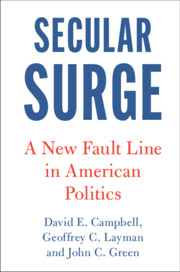30 results
The Pandemic and Political Behavior: Staying the Course
-
- Journal:
- PS: Political Science & Politics , First View
- Published online by Cambridge University Press:
- 30 January 2024, pp. 1-6
-
- Article
-
- You have access
- Open access
- HTML
- Export citation
7 - Secularism and Party Politics
-
- Book:
- Secular Surge
- Published online:
- 14 January 2021
- Print publication:
- 03 December 2020, pp 138-151
-
- Chapter
- Export citation
11 - Beyond the Secular Surge
-
- Book:
- Secular Surge
- Published online:
- 14 January 2021
- Print publication:
- 03 December 2020, pp 209-223
-
- Chapter
- Export citation
10 - Secularism on the Stump
-
- Book:
- Secular Surge
- Published online:
- 14 January 2021
- Print publication:
- 03 December 2020, pp 181-208
-
- Chapter
- Export citation
6 - Nonreligiosity and Backlash Politics
-
- Book:
- Secular Surge
- Published online:
- 14 January 2021
- Print publication:
- 03 December 2020, pp 107-137
-
- Chapter
- Export citation
Index
-
- Book:
- Secular Surge
- Published online:
- 14 January 2021
- Print publication:
- 03 December 2020, pp 243-250
-
- Chapter
- Export citation
Acknowledgments
-
- Book:
- Secular Surge
- Published online:
- 14 January 2021
- Print publication:
- 03 December 2020, pp xvi-xviii
-
- Chapter
- Export citation
3 - Public Secularism
-
- Book:
- Secular Surge
- Published online:
- 14 January 2021
- Print publication:
- 03 December 2020, pp 45-68
-
- Chapter
- Export citation
1 - The Secular Surge
-
- Book:
- Secular Surge
- Published online:
- 14 January 2021
- Print publication:
- 03 December 2020, pp 1-21
-
- Chapter
- Export citation
A Closer Look
-
- Book:
- Secular Surge
- Published online:
- 14 January 2021
- Print publication:
- 03 December 2020, pp xiii-xiv
-
- Chapter
- Export citation

Secular Surge
- A New Fault Line in American Politics
-
- Published online:
- 14 January 2021
- Print publication:
- 03 December 2020
2 - America the Secular
-
- Book:
- Secular Surge
- Published online:
- 14 January 2021
- Print publication:
- 03 December 2020, pp 22-44
-
- Chapter
- Export citation
5 - Secularism and Political Attitudes
-
- Book:
- Secular Surge
- Published online:
- 14 January 2021
- Print publication:
- 03 December 2020, pp 83-106
-
- Chapter
- Export citation
4 - Secularism and Civic Engagement
-
- Book:
- Secular Surge
- Published online:
- 14 January 2021
- Print publication:
- 03 December 2020, pp 69-82
-
- Chapter
- Export citation
Preface
-
- Book:
- Secular Surge
- Published online:
- 14 January 2021
- Print publication:
- 03 December 2020, pp xv-xv
-
- Chapter
- Export citation
Copyright page
-
- Book:
- Secular Surge
- Published online:
- 14 January 2021
- Print publication:
- 03 December 2020, pp vi-vi
-
- Chapter
- Export citation
Contents
-
- Book:
- Secular Surge
- Published online:
- 14 January 2021
- Print publication:
- 03 December 2020, pp ix-ix
-
- Chapter
- Export citation
Dedication
-
- Book:
- Secular Surge
- Published online:
- 14 January 2021
- Print publication:
- 03 December 2020, pp vii-viii
-
- Chapter
- Export citation
Figures
-
- Book:
- Secular Surge
- Published online:
- 14 January 2021
- Print publication:
- 03 December 2020, pp x-xi
-
- Chapter
- Export citation
8 - Secularism and the Democrats
-
- Book:
- Secular Surge
- Published online:
- 14 January 2021
- Print publication:
- 03 December 2020, pp 152-165
-
- Chapter
- Export citation



